A Spanish chef offers a sweet interview the last day of the year
Thursday, December 31, 2015
This morning, I was listening to the radio and, suddenly, the presenter of the programme interviewed a Chef, from Navarre, Angelita Alfaro, to talk about her new book, and it made me laugh, when she said the title of the book: “Mis postres” ("My desserts"), because it resembles the title of my blog: "Mis fotos” ("My Photos"). I know that they are not the same subject; but, in this case, are themselves related, because, in the book of Angelita, there are many photos of desserts.
Moreover, I wanted to talk about this book, because I love desserts; I have a sweet tooth.
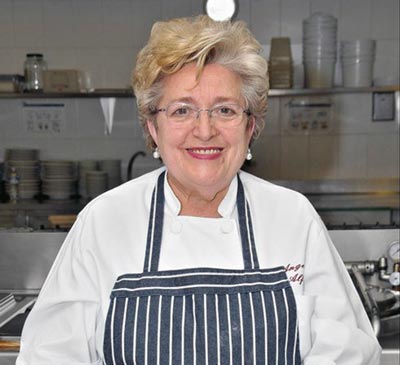
Angelita Alfaro

The book "My desserts"
In this book, Angelita has collected the best recipes, that she learned from her mother and her aunts.
On October 8, Angelita presented this book, "My desserts", in Pamplona.
This is a book in which the reader will find over 70 easy recipes, with a detailed list of ingredients and measurements, the final result great photos and detailed explanations. Food experts and chefs, Elena Arzak, Rafael Anson and Jose Maria Gorrotxategui have prefaced the book.
In the the presentation, Angelita Alfaro was accompanied by Alex Mugica, chef of the restaurant “La cocina de Alex”.
Desserts are the culmination of any food, and they are a real ritual for the senses, small jewels to get a trace on the diners. Angelita Alfaro brought together, in this book, her tastiest pastry recipes, to bring the art of desserts sweet lovers. Biscuits, cakes, churros, ice cream, French toast ..., this book can unite desserts always with the latest trends, which makes it suitable for cooking enthusiasts of all levels.
According to Elena Arzak, "This work is baking recipes, from the most popular, with the taste of home to her land, principally, to elaborations high posh, some historical and many of them international".
Angelita Alfaro was born in La Rioja, but lives in Pamplona, since her youth. She is the author of the bestseller “La cocina de Angelita” (“The cuisine of Angelita”, 1991, seven editions) and 19 other books, including “Gran cocina navarra”(“Great navarre cuisine”), “Cocina de Navarra” (“Cuisine of Navarra”), “La dieta de la vida” (“The Life Diet”), “Cocina para estudiantes, solteros, separados, divorciados,viudos y vagos” (“Cuisine for students, single, separated, divorced, widowed and vague”), “Recetas con encanto” (“Recipes with charming”. “Cocina tradicional y Gourmet” (“Traditional & Gourmet Cuisine”).
Angelita collaborates in different media, such as Canal Cocina (Cuisine channel). Her work has received awards and support of internationally renowned chefs like Juan Mari Arzak and Martin Berasategui. She has multiple Gourmand Cookbook Award, in the categories of Best cookbook and health and Best Book for gift.
She is specialized in traditional cuisine from La Rioja and Navarra, although with touches of modernity. She sleeps few hours and combines her passion for gastronomy with hand crafted of espadrilles, that she sends to personalities like the Pope or members of the royal family. For her, the main ingredient, in any dish, is affection. And she has written this book with much affection.
Well, I hope that you can buy this book and anjoy it.
Until my next post, kind regards and a Happy New Year!!!!!!!!.
Luis.
Sponsored by Costaluz Lawyers.
Please click below:

 0
Like
Published at 9:57 PM Comments (0)
0
Like
Published at 9:57 PM Comments (0)
A very Christmas dish in Spain
Tuesday, December 29, 2015
Today I would like to show you a video with the recipe for a Christmas dish in Spain: “the Almond Soup”
I know this dish is usually cooked in Christmas Eve; but perhaps you could cook it on next year.
If you want to see the video, please click below:
http://www.rtve.es/alacarta/videos/aqui-la-tierra/aqui-tierra-sopa-almendras-tradicion-continua/3420570/
Marta (the presenter): “Formerly, it was tradition, on Christmas Eve, take, for dessert, "almond soup"; very typical of Madrid and the two Castiles. Over the years, it has been lost the recipe; but today we recover it”
Carlos Campo (Manager “El Estragón”): “Formerly, Christmas dinner, on Christmas, you did not dinner….ehhh”
Marta: “How is that you did not have a dinner?!”
Carlos: “You were allowed to have a little soup, you took the Almond soup ……..
Marta: “Because it was the Christmas sweet, that gave you happiness…….”
Carlos: “….but they say that it was made with water, not even with milk, because you could eat neither meat nor milk, on Christmas Eve dinner”
Marta: “Let us see, Carlos, what I want is to learn to do it..”
Carlos: “But, go to the kitchen, with Alejandra, and there we all explain you how to do it…”
Marta: “Well, I think it is great….I am going to kitchen…..Thanks, Carlos……”
Carlos: “Fine, Marta…..to you, Marta..…”
….music….
Marta: “Let us see, Alejandra, I have come here, to learn the recipe for almond soup, because I do not want it to miss, I want that people can do it at home ... tell me what ingredients it has”
Alejandra David (“El Estragón”): ”One liter of milk, for example; 200 grams of almond paste; this is already almond compacted, made industrially; but, formerly, it was made by ladies, with a mortar, and patiently and slowly ... and you were going adding sugar gradually, slowly, until it was made a paste; and, then, pine nuts, cinnamon and stale bread ...... There are many versions of this recipe: some thicker versions and lighter versions; we keep light, with a bowl of spoon. It is very good, very easy, very cheap, everyone can make it in its home ...”
Marta: “Then come on, let's see, Alejandra”
……music…………………….
Marta: “And it so should remain….”
Alejandra: “That is, ready……..The good thing, about this dessert, is that, once cooled, you can leave it in the fridge, from one day to another, and it is even better the next day”
Marta: “Since this one makes such excellent impression, What do you think, Alejandra, if you prepare for me a lot of almond soup and I go to street, in order that people know again this dish, such a typical Christmas?”
Alejandra: “This is fact, very well, now we do it”
Marta: “Yes?, then come on, let's set ourselves, get on with it, here, to cook”
……………….music…………………
Marta: “I am going to offer you a shot and let´s see if you know what it is…..Let´s see if she likes it or if she does not like it…”
A girl: “Ummm…of coconut”
Marta: “Nooo….It is a Christmas recipe”
The same girl: “Ummm, so good”
A man: “It has pineapple…..”
Marta: “Pineapple, no”
The same man: “It tastes like nougat”
Marta laughs…
The same man: “Rice pudding”
Marta: “Rice pudding….!!!, but hey….What says your friend?”
The friend: “That is coffee, with pineapple, almond .....”
The first man: ”We will not get on TV, Right?”
A third man: “Coconut”
Marta: “Coconut, no”
The man´s wife: “I have no idea”
Another lady: “Almond?”
Marta: “Very weeeellll…!!!!...Do you see how you knew it?, this is almond soup”
The lady: “Ah, almond soup…, ah, what a rich…”
Marta: “Sign off this report”
The lady: “Well, Merry Christmas, to all, and that there is work, for everyone ... And, up to here, the report of Spanish Television ......”
Well, I hope that you have liked this video and you want to try cooking the “Almond soup”.
Until my next post, kind regards,
Luis.
Sponsored by Costaluz Lawyers.
Please click below:

 0
Like
Published at 11:18 AM Comments (0)
0
Like
Published at 11:18 AM Comments (0)
A Spanish researcher creates the Method Chest for use with dogs
Thursday, December 24, 2015
I have just found an interesting news: A Spanish researcher creates a method to save lives.
This Method is called “Arcón” ("Chest") and it optimizes the olfactory performance of search dogs, enabling the rescue of many human and animal life, in the world.
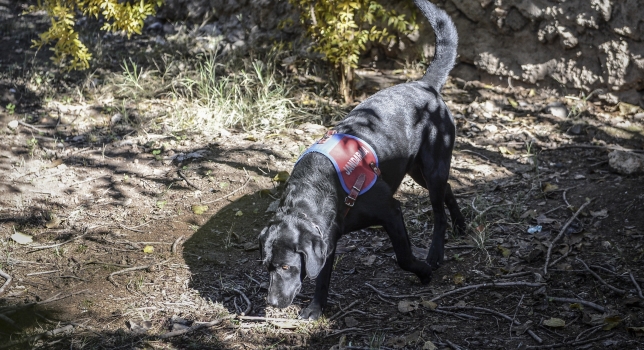
A search dog tracks during an anti-terrorist operation in southern Turkey
The Method Chest has managed to optimize the olfactory performance, among other things, of search dogs, detection and rescue, consequently enabling the rescue of many human and animal life, in the world.
The Method Chest is the only system of search, detection and rescue endorsed a scientific and academic level (it integrates studies plan in university), formalized by governments and awarded by numerous institutions like the UN.
It is moreover the only one, that has demonstrated, official and internationally, achieving optimize the olfactory performance of search and rescue dogs, enabling the rescue of many human and animal lives, whether regarding buried people alive (earthquakes, landslides, explosions) lost or detecting explosives, mines, protected animal species, human remains, etc.
This is demonstrated by their extraordinary results since 1999, in real interventions, against all existing systems, such natural as artificial. Unlike these, the Method Chest, and its inherent perceptual performance, is also enabling the salvage of lives, as the authorities establish in numerous operations.
For example, dogs, from the Colombia National Police Method Chest, detected mines in all its operations, no casualties of any kind and, at the Galapagos National Park (Ecuador), dogs Method Chest of the UPMA increased their detection, in terms of traffic of protected wildlife.
The Method Chest was created after twelve years of hard scientific research and innovation by the renowned Spanish researcher, Jaime Parejo Garcia, who has received many important awards, for his scientific innovation, as a crucial heritage to science and humanity.
This innovative and revolutionary methodology mainly comprises a total of 7 techniques, associated with a specific learning process, that optimizes the levels of autonomy, motivation and concentration of the dog during the search and detection, even in extreme adversity and difficulty.
Thus, the results in confined spaces, with no visibility, are improved, optimizing the degree of olfactory perceptual performance, the inhibition of potentially interfering stimuli (selecting and discriminating them), the functional activation of associated informative data and housed systems of response on rote warehouse of dog, as well as the progressive and systematic development of canine search strategies, especially fruitful.
Their results clearly demonstrate the special magnitude of the advance, that involves this methodology, in favor of humanity. During the earthquake, in Ducze, Turkey, in November 1999, a person was located alive by a dog of the Method Chest, at the Canine Rescue Unit of the Fire Department of the Provincial of Huelva. In 2001, another earthquake occurred in India, in Gujarat, where, thanks to a dog of the Method Chest, it managed to locate a man alive.
In situations, like these, they have found many people alive; undoubtedly, one of the most important operations was which held, in Guatemala, in October 2015, where a landslide, in El Cambray, buried a lot of people. A Canine Rescue Unit of the Distinguished Volunteer Fire Department of Guatemala, trained with the Method Chest, located a total of 37 people alive.
Well, I hope that you have liked this article, such as I did.
Until my next post, Merry Chistmas and a Happy New Year 2016.
Luis.
Sponsored by Costaluz Lawyers.
Please click below:

 0
Like
Published at 10:44 PM Comments (0)
0
Like
Published at 10:44 PM Comments (0)
Ten nice and historic destinations in Spain
Friday, December 18, 2015
I have found an article, in which a list of some of the most beautiful villages of Spain was given. Some of them may already be known by you and others will be known by you, for the first time. This classification is made by ABCViajar.
The first village is Santillana del Mar. This is a nice village, situated in the western coast of Cantabria, in the North of Spain.
Close to Santillana, you can visit the famous “Cave of Altamira”. Therefore, many tourists visit this village, every year.
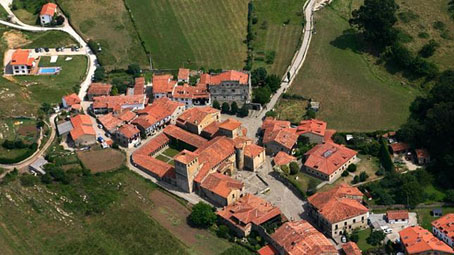
A general view of Santillana del Mar, Cantabria, North of Spain
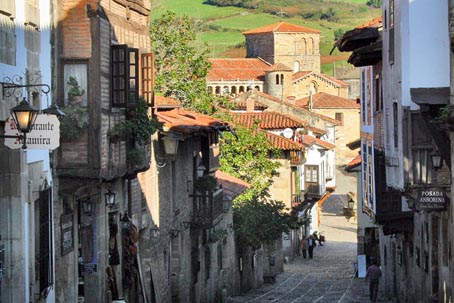
Santillana del Mar
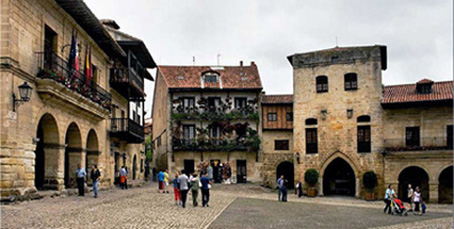
Main square in Santillana del Mar

The Collegiate church in Santillana

The Collegiate of Santillana inside

A nice street in Santillana
Another nice village is Castrillo de los Polvazares, in León, in the North western Spain.There you can eat a famous dish, named “Cocido maragato”. The “Cocido Maragato” (“Stew Maragato”) is a stew consisting basically in a soup, collard greens, potatoes, chickpeas and seven varieties of meat. It is characterized mainly because it is served "backwards", ie, first cooked meats, then vegetables and, finally, soup. Where do you can eat this stew and another dishes; well, I recommend you the Hostería Casa Coscolo, on the street El Rincón, 1, (Plaza de la Iglesia), Castrillo de los Polvazares, Astorga, León. Telephone number: 987 691 984. Mobile: 619 280 540.
Castrillo de los Polvazares is situated beside the Santiago´s road. Its name comes from the Maragatería region.
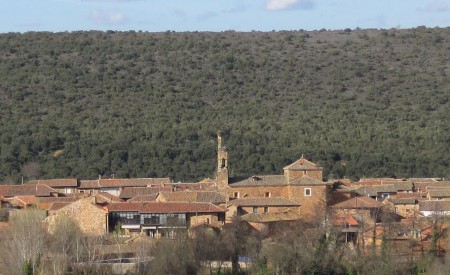
Castrillo de los Polvazares
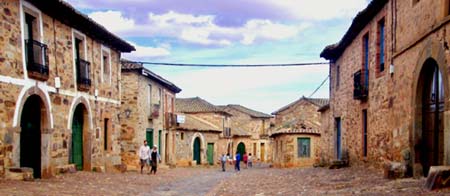
Castrillo
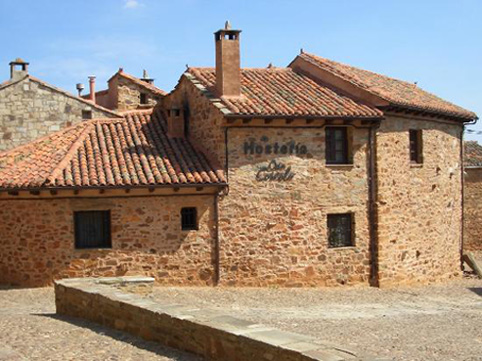
Hosteria Casa Cascolo
Now, I am going to tell you about the village La Alberca, in the Sierra de Francia, Castilla-León, North western Spain.
Almost all the buildings, in La Alberca, were made between the seventeenth and eighteenth centuries.
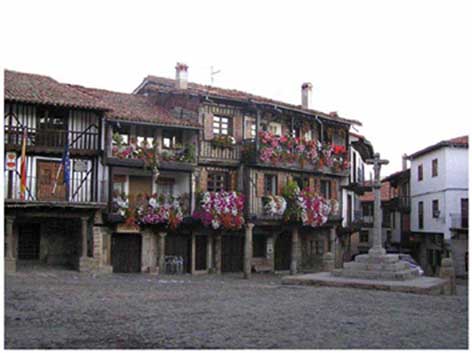
The nain square with a cross in La Alberca
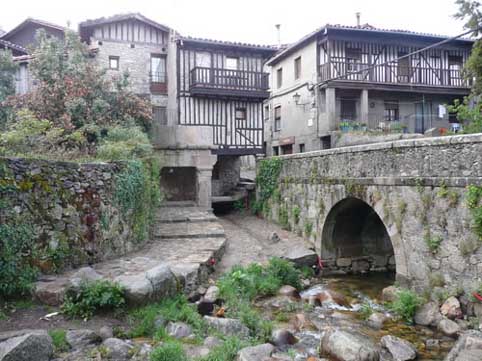
House country river La Llana, La Alberca
Another important village is Albarracín. It is situated in the province of Teruel and the region of Aragón, in northeastern Spain. It is declared National Monument, since 1961. And it is waiting for being declared World Heritage Site, by UNESCO, thanks to the beauty and important of its historic patrimony. This is one of the greatest villages, cause of historic reasons, in the province of Teruel.
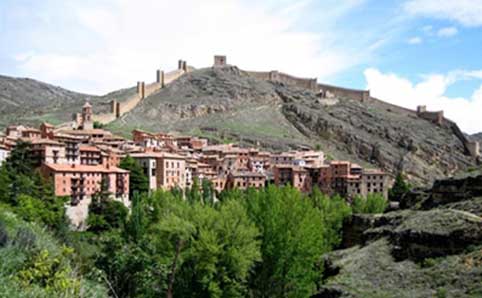
Albarracín with its walls

Albarracin

Cathedral of Albarracin
Now, I am going to talk to you a little bit about the village Morella, in the north of the province of Castellón (east of Spain, higher than Valencia).
Morella climate is high mountain Mediterranean (fresh in summer and a cold winter).
Morella is bordering on Teruel. The N-232 is the communication hub of Morella with Zaragoza and Logroño. Also, this road connects Morella with the Valencian coastal tourist destinations, with the Mediterranean Motorway (A-7) and the N-340. From Castellón, you can also access the city, by the N-238, which links later with the N-232, towards Morella.
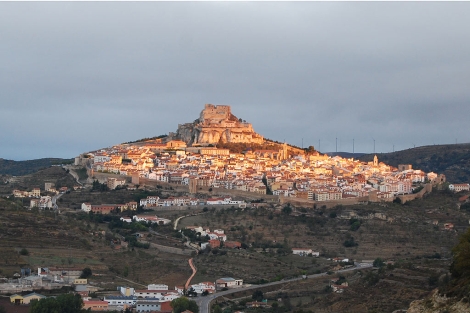
Morella, Castellon

Castillo de Morella

Morella from the Castle
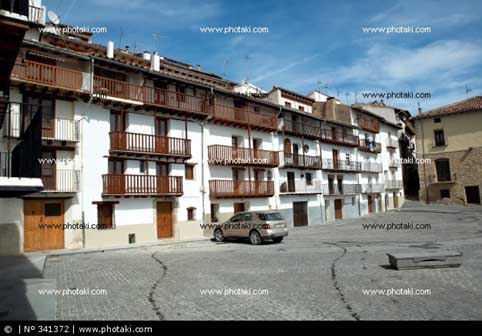
The main square in Morella
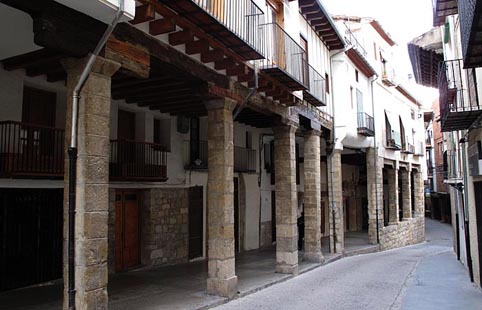
A Medieval street of Morella
The next village, that I want to show you, is Guadalupe, in the province of Caceres, in the Autonomous Community of Extremadura (northwest of Andalucia).
According to tradition, a shepherd found a statue of the Virgin Mary, on the Guadalupe River, in the late thirteenth or early fourteenth century. Near the place, where he found the image, a chapel, around which emerged the current settlement with the name of Puebla de Santa María de Guadalupe, was built. Since the construction of the first sanctuary, Guadalupe became the most important pilgrimage centre of the Iberian Peninsula, after Santiago de Compostela, a condition that continues, today, through the pilgrimage arrives, in Spain, on the roads of Guadalupe. This is due to the fact that, if Santiago is the patron of Spain, the Virgin of Guadalupe is the patron saint of all Spanish-speaking lands and holds the title of Queen of Spain, by the Catholic tradition. The current Monastery of Santa María de Guadalupe is considered one of the greatest symbols of Extremadura and the Virgin of Guadalupe is patroness of this region. Anyway, there are another important monuments.

Guadalupe, Caceres
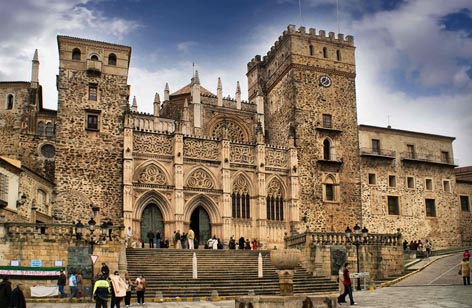
The Monastery of Guadalupe
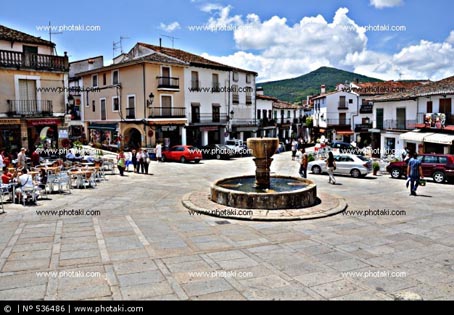
The Main square of Guadalupe

A street of Guadalupe
Going from the south to the north western Spain, we arrive to the village Aínsa, in the province of Huesca and the region of Sobrarbe, Autonomous Community of Aragón.
Aínsa is situated in the Pyrenee of Huesca. And, beside Boltaña, it is the historical head of the region of Sobrarbe, of the old County of Sobrarbe.
The original nucleus, that is located on a promontory overlooking the confluence of the Cinca and Ara rivers, consists of two almost parallel streets, the Mayor street and Santa Cruz street; the Plaza Mayor, which is situated below the castle, in an esplanade, near the Covered Cross temple, where legend places the miracle of the appearance of the cross, on an oak fire, which gave victory to the Christian troops, under the King García Jiménez.
With clear medieval layout, the historic town of Ainsa is declared a “Historic-Artistic Site”, in 1965.
 a 4 cm.jpg)
Plaza Mayor (Main Square) of Aínsa
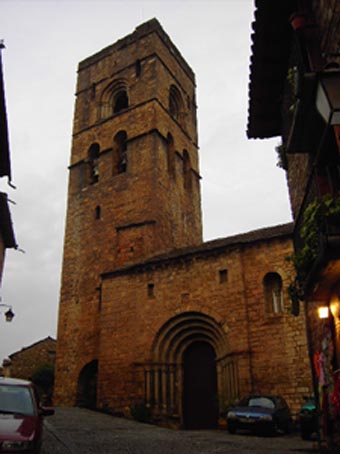
The Church of Santa María, in Aínsa
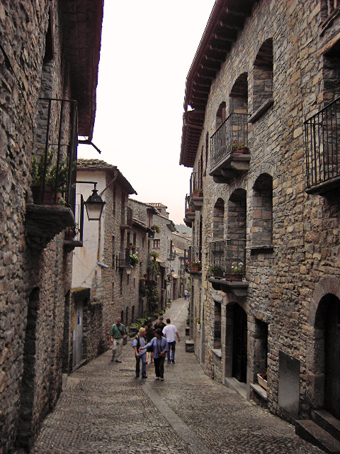
Main street of Ainsa
Now, I should like to show you another nice city, in the north of Spain: Frias. It is in the north of the province of Burgos, in the region of Las Merindades, in the Autonomous Community of Castilla-Leon (North-west of Spain).
On the hill of La Muela, and close to the wide and mighty river Ebro, a strategic enclave of passage of that river was formed, since Roman times and especially in medieval times, linking the Cantabrian coast and the plateau, leading remarkable prosperity to Frias and its monuments.

Frias, Burgos
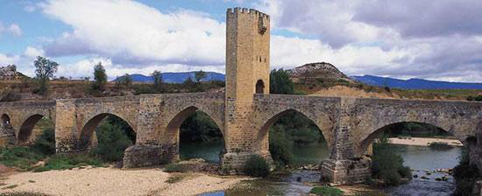
The River Ebro close to Frias
It maintains a medieval urban structure, that crowns the castle of the Velasco and the church of San Vicente. Buildings maintain an structural system, in which they join firmly together. The upstairs suntrap employs tuff and a lattice of wood.
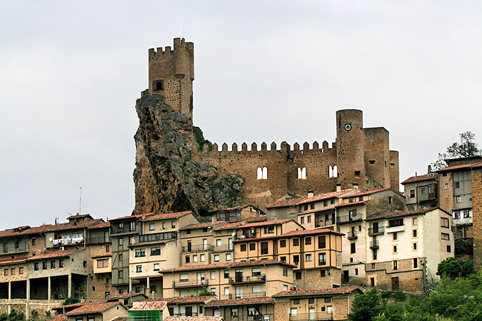
The Castle of Frias
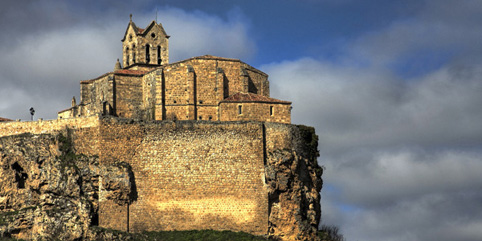
The church of San Vicente, Frias, Burgos
A curiosity: Frias is the smallest city in Spain.

A typical street in Frias
I want you to pay attention to another nice village: Pedraza de la Sierra. It is situated in the province of Segovia, 37 kms to the northeast from the capital. it is a walled medieval town. Its careful rehabilitation motivated its declaration as Historical Set, in 1951.
Its name seems to derive from the Roman Pretoria, although the first historical data back to Mr. Fernando Gomez de Albornoz, greater commander of Montalban, who was appointed, by the King Henry II of Castile, Lord of Pedraza. Later it passed into the hands of the Herrera family and the late fifteenth century, it passed to the constables of Castile, by marriage of Mrs. Blanca Herrera and Mr. Bernardino Fernandez de Velasco. It was remained, in these hands, until the manors were abolished, in the nineteenth century. The constables settled there, being the place waypoint for great personalities such as artists, nobles and monarchs. In the sixteenth and seventeenth century, the heyday of the village took place, and it is when the most houses and palaces date. This prosperity was due, among other things, to export to northern Europe, of the wool of their flocks of Merino sheep and their excellent fabrics, able to compete with the best, that were made in Flanders.
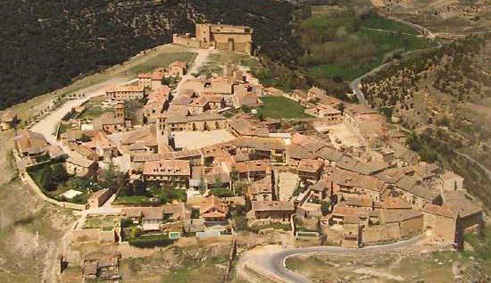
Pedraza de la Sierra, Segovia
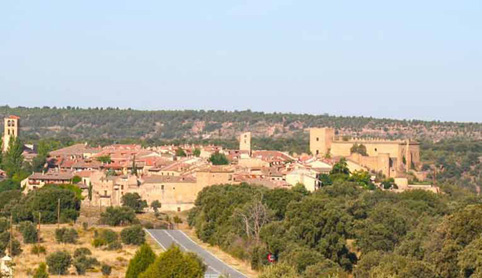
A view of Pedraza
The door of the villa is the only access to Pedraza, and therefore is used as input and the only way out of the town. Its origins date back to the eleventh century, and was rebuilt in the sixteenth century as the Lord of Pedraza, Iñigo Fernandez de Velasco, whose coat dominates the entrance. The gates are made of black poplar and, during several centuries, they were closed overnight, preventing the entry or exit of any person, except emergency; in that case, the jailer was responsible for opening the door.
 a 16 cm.jpg)
The door of the villa of Pedraza

Open gates to exit from Pedraza
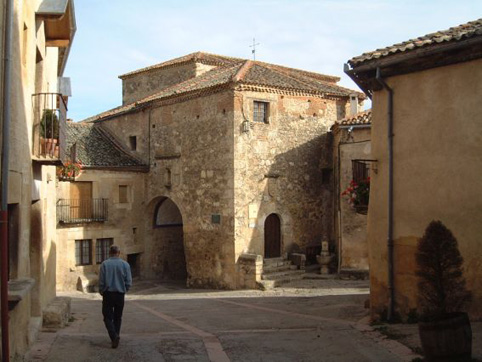
A nice street of Pedraza
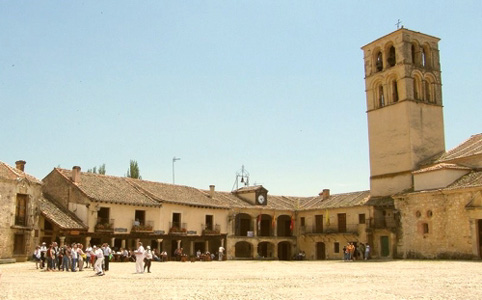
Main Square of Pedraza and the tower of the church

Another street of Pedraza
The town is decorated with thousands of candles at the beginning of July (first and second Saturday of that month). Public lights are switched off and many windows are closed, if you want to catch some light, in order to highlight the street lighting, windows, squares, gardens and patios. Simply placing lit candles takes several hours in the evening.
 a 16 cm.jpg)
"La noche de las velas" (the night of candles), at sunset, in Pedraza
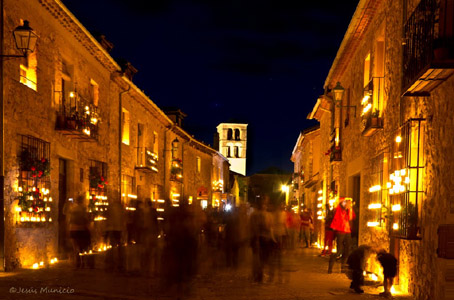
La noche de las velas in Pedraza
And, finally, another nice village is Urueña, in the province of Valladolid, in the Autonomous Community of Castilla y Leon, in the northwest of Madrid.
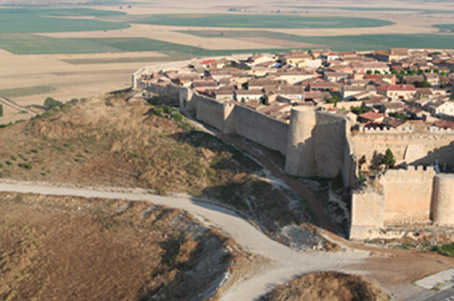
Urueña with its wall
Urueña has one of the best preserved urban centres of the province of Valladolid, offering its visitors the appearance of a small town medieval. For this reason, it was been declared a Historic-Artistic Site, in 1975. It retains much of the wall, with two of its doors.
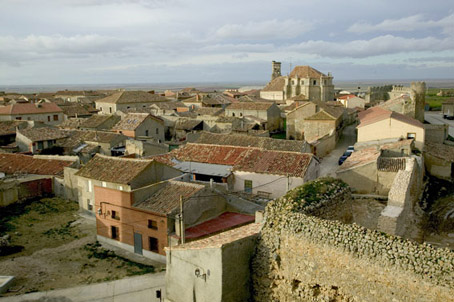
Villa of Urueña
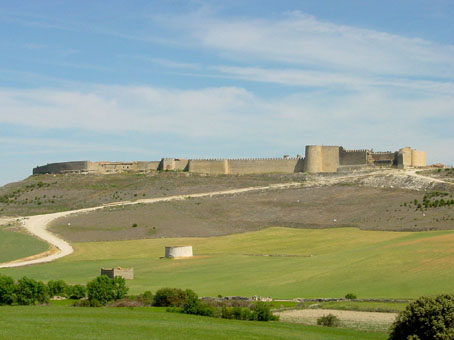
The wall of Urueña
It also preserves some paintings of the castle.
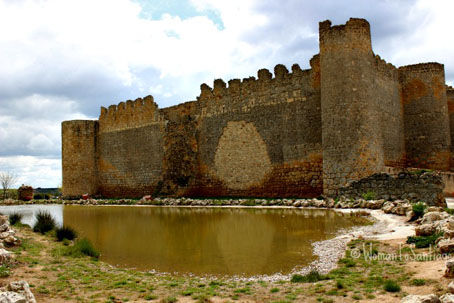
The Castle of Urueña
And it is very important the Hermitage of Nuestra Señora de la Anunciada. The invocation of the Virgin Annunciation is a long tradition, in this town, celebrating its festivitie,s on March 25, and the pilgrimage, on September 8.
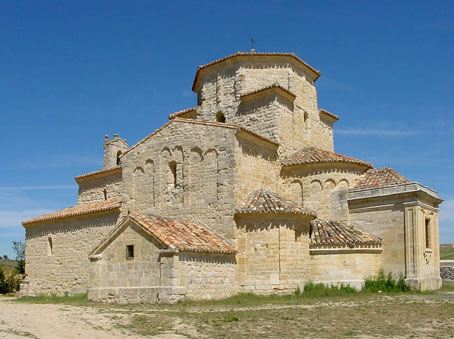
Hermitage Nuestra Señora de la Anunciada, Urueña, built in the century XI
There are also some large houses of stone.
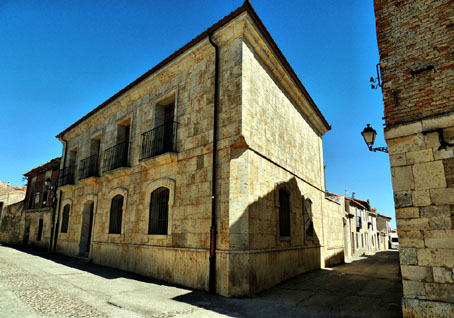
Large houses of stone in Urueña
The church of Santa Maria de Azogue is the only church, in Urueña, and it is within the walls, beside the “Door of the Azogue” and built among the centuries XVI and XVIII. It has three styles: Gothic, Renaissance and Baroque.
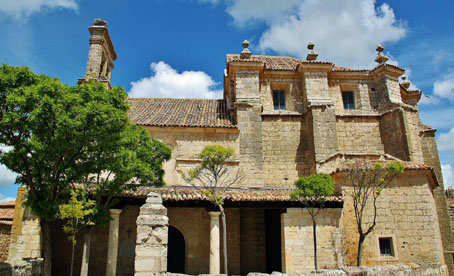
Church Santa Maria of Azogue, Urueña
Well, I hope that you have liked this post and, above all, I should be happy if you could come to Spain, in order to visit any of these places. If it is so, please comment it here, in Eye On Spain.
Thanks for reading my blog and, until my next post, kind regards,
Luis.
Sponsored by Costaluz Lawyers.
Please click below:

 0
Like
Published at 10:35 AM Comments (0)
0
Like
Published at 10:35 AM Comments (0)
Post is testing drones to ensure the postal service in areas of difficult access in Spain
Wednesday, December 9, 2015
I have just found a video, that talks about a curious news: “Post is testing drones to ensure the postal service in areas of difficult access in Spain”. If you want to watch this video, please click below:
http://www.rtve.es/alacarta/videos/telediario/td2-correos-041215/3393896/
Voice in off: “So: in hand and out loud, a rural postman delivered in 1984; today, they are 7000, with a job, of many kilometres, by car, by bike and on foot, which can be complicated, in winter. For facilitate service, in areas of difficult access, Post is studying to use drones”.
Jordi Escruela (Assistant Manager of Innovation at Post): “If we have a hundred percent convenient service and there are moments, that we can not give it, let us seek alternatives, that exist”
Voice in off: “The company has tried them, in Sotres, in the Picos de Europa; they go and return alone, guided by GPS; they can take packages up to a kilogram and a half of weight”
Álvaro López (Manufacturer drones “USOL”): “It is a system, with six electric motors, each engine has a thrust of 3 kilos and a half, --it is a quite powerful system--".
Alberto Freile (Voice in off): “Post says that they would not replace the rural postmen, but that they would be a complementary tool, for a trade, which has seen few change”
Jesus Guzmán (main actor, as Braulio, in “Crónicas de un pueblo” (“Features of a village”)): “Precisely the streets are public roads, for passing cars, trucks and people”
Xan das Bolas (a shepherd and a street cleaner, as Camilo, in “Crónicas de un pueblo”): “Watch it, how rich….. and sheeps not...... “
Jesus Guzmán (Braulio): “Get them off, that they do not bump into my way….”
Well, I think that it is very interesting that many people can receive any package, wherever they are.
I hope that you have liked this video.
Until my next post, kind regards,
Luis.
Sponsored by Costaluz Lawyers.
Please click below:

 0
Like
Published at 9:01 AM Comments (0)
0
Like
Published at 9:01 AM Comments (0)
Spanish researchers develop a peptide with potential in the treatment of Ictus
Saturday, December 5, 2015
I have just seen a news, that I have liked, for two reasons: because it has to do with some Spanish women scientists –it is sad, but in Spain there are few women scientists—and because they have led a very important project, about Ictus. Concretely, the news says the following: “Spanish researchers develop a peptide with potential in the treatment of Ictus”.
With six million deaths, per year, ictus or stroke is the second cause of death, in the world, and the first of disability in adults, a high prevalence, that will increase with the aging of the population, and for now, a team of Spanish scientists has laid the groundwork for future therapy.
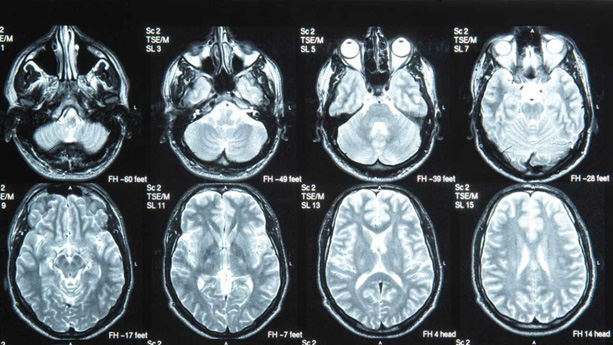
Images of a brain with Ictus
Currently, the only effective therapies, for the treatment of ischemic stroke, are aimed at dissolving thrombus or the blood clot, causing arterial blockage, some drugs, that must be given within the first 4 hours, after the onset of symptoms, and are only useful to 10% of cases.
Now, a team, led by researchers (women) from the Institute of Biomedical Research (CSIC-UAM) and CIBERNED, has laid the foundation, to develop a new therapy for stroke.
The team, made up entirely of women, led by Teresa Iglesias and Margarita Diaz-Guerra, from the Institute for Biomedical Research (CSIC-UAM), has developed a neuroprotective peptide --derived from the Kidins220 / Arms protein-- able to reduce neuronal death, by excitotoxicity, one of the pathological mechanisms, implicated in stroke and other neurodegenerative diseases. The study, published in the journal “Cell Death and Disease”, explores the potential of Kidins220 / ARMS, as a therapeutic target.
The research group has been characterizing prosurvival intracellular signaling cascades, ie, groups of molecules, that cooperate, between them, to cause cells to stay alive and whose activity is profoundly altered, when the stroke occurs.
The idea was to use this knowledge, to develop therapeutic tools, to interfere in the process of secondary neuronal death that occurs after primary damage, and is responsible for the expansion of the infarct core and the worsening of neurological damage.
"We can not predict when a heart attack will happen, either avoid the primary ischemic damage", caused by decreased blood flow, to the affected area, but "it would be possible impact on secondary neuronal death, ie, protect the surrounding infarction neurons, to better support the cascade of events, ending with the function of their ways of survival", the article explains.
"Really, this is a fight against time and these new therapeutic strategies could have an early neuroprotective effect and reduce the neurological involvement of patients, while the blood flow is restored", say the authors of the work.
Well, I hope that you have thought how interesting is this work, such as I did.
Until my next post, kind regards,
Luis.
Sponsored by Costaluz Lawyers.
Please click below:

 0
Like
Published at 12:32 PM Comments (0)
0
Like
Published at 12:32 PM Comments (0)
A Spanish Professor discovers the relationship fungi-Alzheimer´s
Thursday, December 3, 2015
I have just found a very interesting video, about a great discovery by a Spanish Professor: Luis Carrasco has discovered that fungi in brain are related to Alzheimer´s. If you want to watch this video, please click below:
http://www.rtve.es/alacarta/videos/telediario/cientificos-espanoles-descubren-cerebros-pacientes-alzheimer-estaban-infectados-hongos-su-propia-flora/3387042/
Voice in off: “This Professor of Microbiology became blind, twenty years ago; they failed to tell the cause, but he found, by himself, that a fungal infection was to blame. Since then, he believed that fungi are also associated with Alzheimer´s --and he has just proved it--".
Luis Carrasco (a Professor, at the Universidad Autonoma de Madrid): ”What we have seen is that, in the brains of dead people with Alzheimer's, have a clear infection, by fungi, in different parts of the brain”
Voice in off: “For that, in this laboratory, there have been fourteen brains of people, who died from Alzheimer's and other as people, who died for other reasons”
A doctor: “In the brain with Alzheimer´s, there is a fungal infection”
Voice in off: “The fungi found, in the brains of Alzheimer's patients, are fungi that normally have in the intestinal or buccal mucosa; for any reason, they cut in the brain and infect it”
Luis Carrasco: “Maybe, it could be that, through the olfactory nerve, is distributed to the entorhinal cortex, first, then the hippocampus and to other parts of the brain”
Angela Alcover (Voice in off): “This finding has been published in the international journal "Scientific Report". This Professor believes that his research opens the door to further, about the causes of Alzheimer's, and calls for some laboratory, bigger, make clinical trials, with medicines, against fungal infections”.
Well, I think this is a very big step forwards, in the fight against the Alzheimer´s. I hope that scientists are able to end this disease someday.
Until my next post, kind regards,
Luis.
Sponsored by Costaluz Lawyers.
Please click below:

 0
Like
Published at 11:04 AM Comments (0)
0
Like
Published at 11:04 AM Comments (0)
Spam post or Abuse? Please let us know
|
|